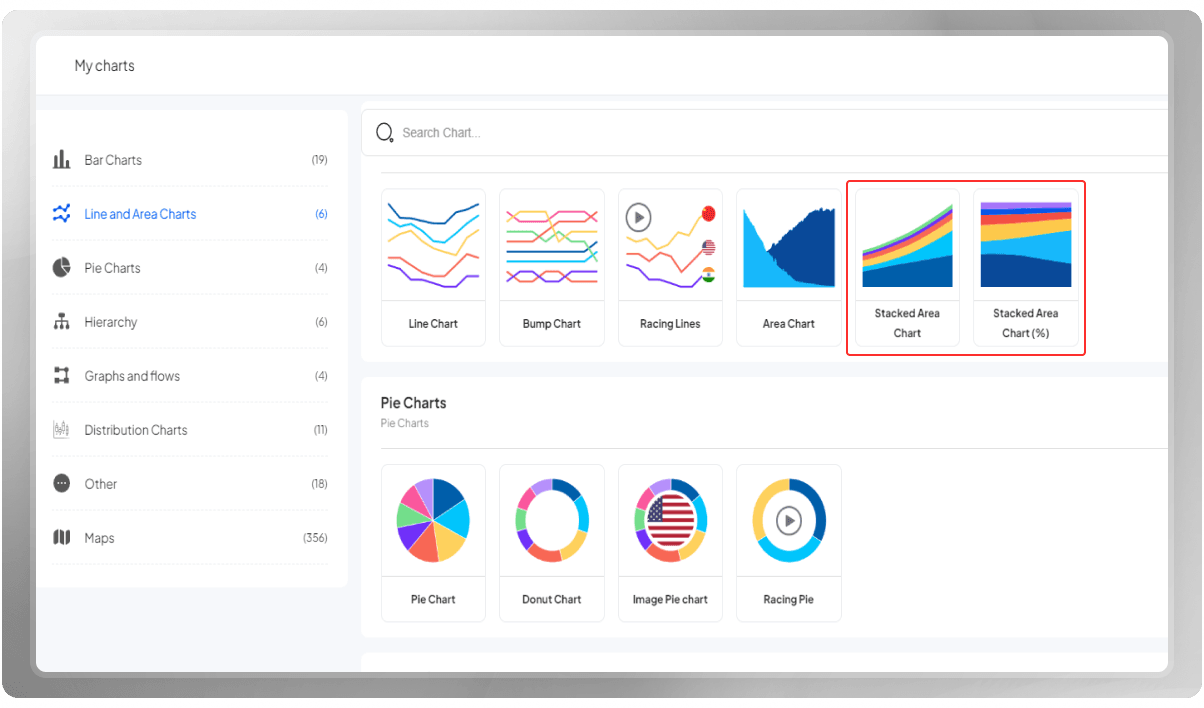What Is Stacked Area Chart and When to Use It

Understanding stack area chart
A stacked area chart is one of the best ways to represent quantitative data over time (or along an ordinal scale). It is particularly useful when you want to show both the total and the composition of multiple categories within a dataset.
In this article, we will explore what stacked area charts are, when to use them, the ideal data for this chart type, situations where they might not be the best choice, and the benefits they offer. Read on to learn the importance of the Stacked Area Chart for data visualization.
What is stacked area chart
If you wish to display multiple categories of data on a common axis, typically representing time or another continuous variable, you can check out the stacked area chart!
In the stacked area chart, each category is depicted as a colored area, and the areas are stacked on top of each other. This visualization helps you provide a clear view of how different categories contribute to the whole and how the composition evolves.
You can use stack area charts for the following purposes:
Visualizing trends
The stacked area chart is an excellent choice if you wish to display trends over time. It allows your audience to see the total magnitude of a variable as well as how individual components contribute to that total.
Each segment of the stacked area represents a category or component of the data. By stacking these segments on top of one another, you can see how the composition of the data evolves over time.
Displaying total magnitude
It doesn't matter if you want to display market share in business, expenditure breakdown in finance, or population distribution in demographics. Make use of a stacked area chart because it makes it easy to grasp the relative proportions of different categories.
In addition, it is highly effective in illustrating the composition of a whole.
The combined height of all the stacked segments at any given point of the chart represents the total value of the data for that time period. That's why a stacked area chart allows you to provide a clear representation of the total magnitude.
The peaked values or periods of significant change in the total magnitude are more apparent in this visualization, making it useful for identifying high or low points in the data.
What is the ideal data for stacked area chart
So, to use the stacked area chart as your go-to data visualization, your dataset should match certain characteristics.
First thing first, your data should have different categories or, at least, have the capacity to be divided into different categories or series. Each category contributes to the whole in a meaningful way.
Stacked area charts work exceptionally well when visualizing data over time or along an ordinal scale. You can use that to your benefit and highlight the variations in your data effectively.
Last but not least, it's better for the data within each category to be on a comparable scale. If you stack the areas with vastly different scales, it can lead to a misleading visualization.
It's crucial to emphasize that the stacked area chart can only accommodate nonnegative (positive) values.
When to avoid stacked area chart
As much as it is essential to know when to use a stacked area chart, it is also vital to know when to avoid it.
Missing values
Keep in mind that a stacked area chart may not be effective if your data is missing values or gaps in the time series. Because of these missing values or gaps, the visualization fails to convey its narrative.
Overlapping data
When data from different categories frequently overlap or intersect, stacked areas can become visually confusing, and the chart might not provide meaningful insights.
Precise data values
A stacked area chart is best for prioritizing trends and proportions over exact figures. As a result, it might not be the best choice for communicating precise data values.
Benefits of stacked area chart in a nutshell
Stacked area charts can be an effective solution for visualizing your data (if it is picked for the right dataset). They offer several advantages. For instance, you no longer need to worry about explaining to your audience how various categories contribute to a whole. You can simply show it.
In addition, the magnitude and composition of different categories are visibly apparent, making it easy for the viewer to compare them. Consequently, the viewer can also recognize patterns and changes within a dataset easily.
With all that has been said, why not use the stacked area chart to tell a data-driven story?

PlotSet allows you to easily create a stacked area chart and customize it according to your preferences. In our template list, as you can see in the image above, we have two stacked area charts: one is a standard stacked area chart, while the other has been uniquely tailored to represent values as percentages.
Via the prepared templates, you can now make your own chart for your data.
Visualize your data with PlotSet!
